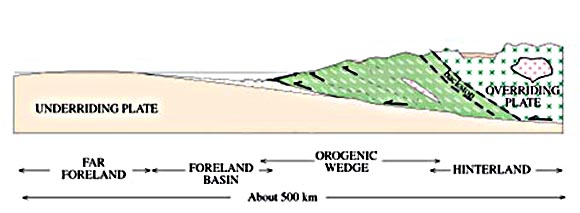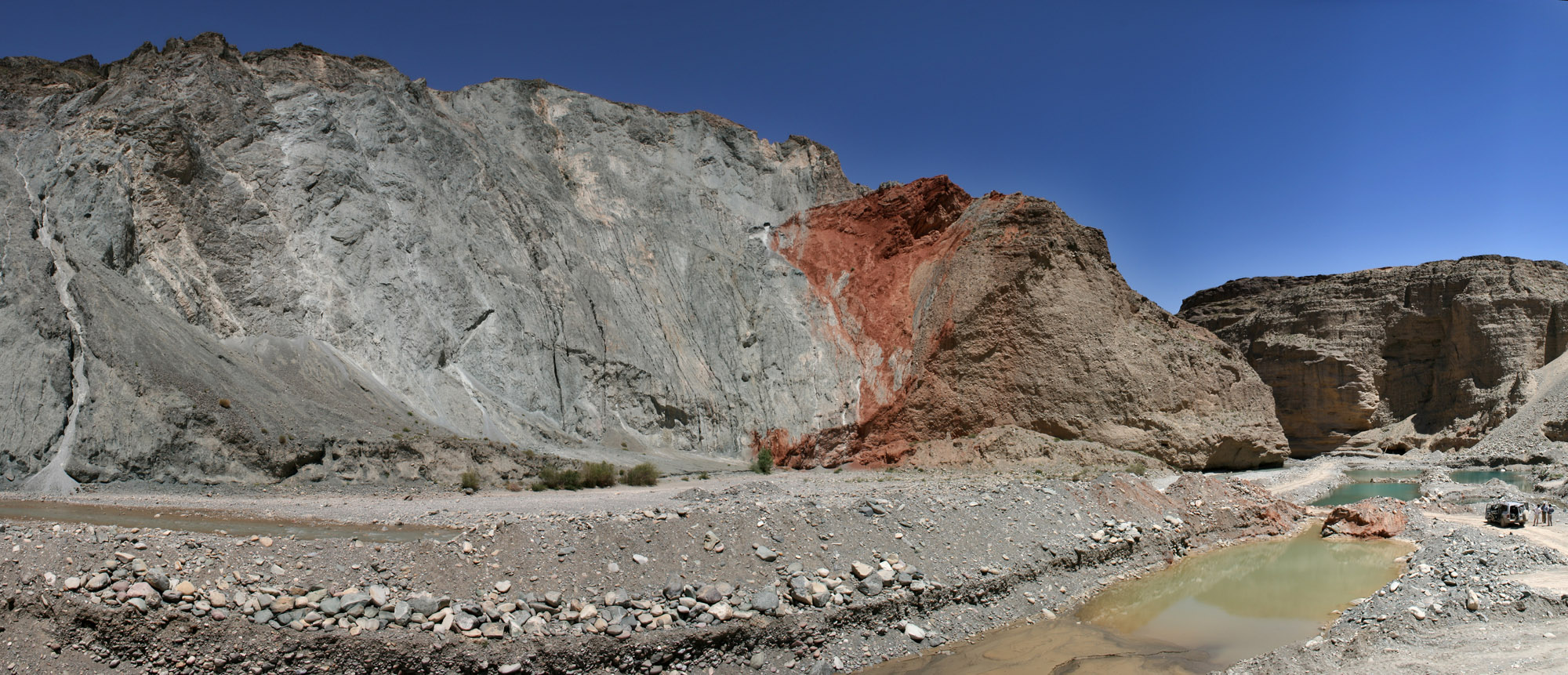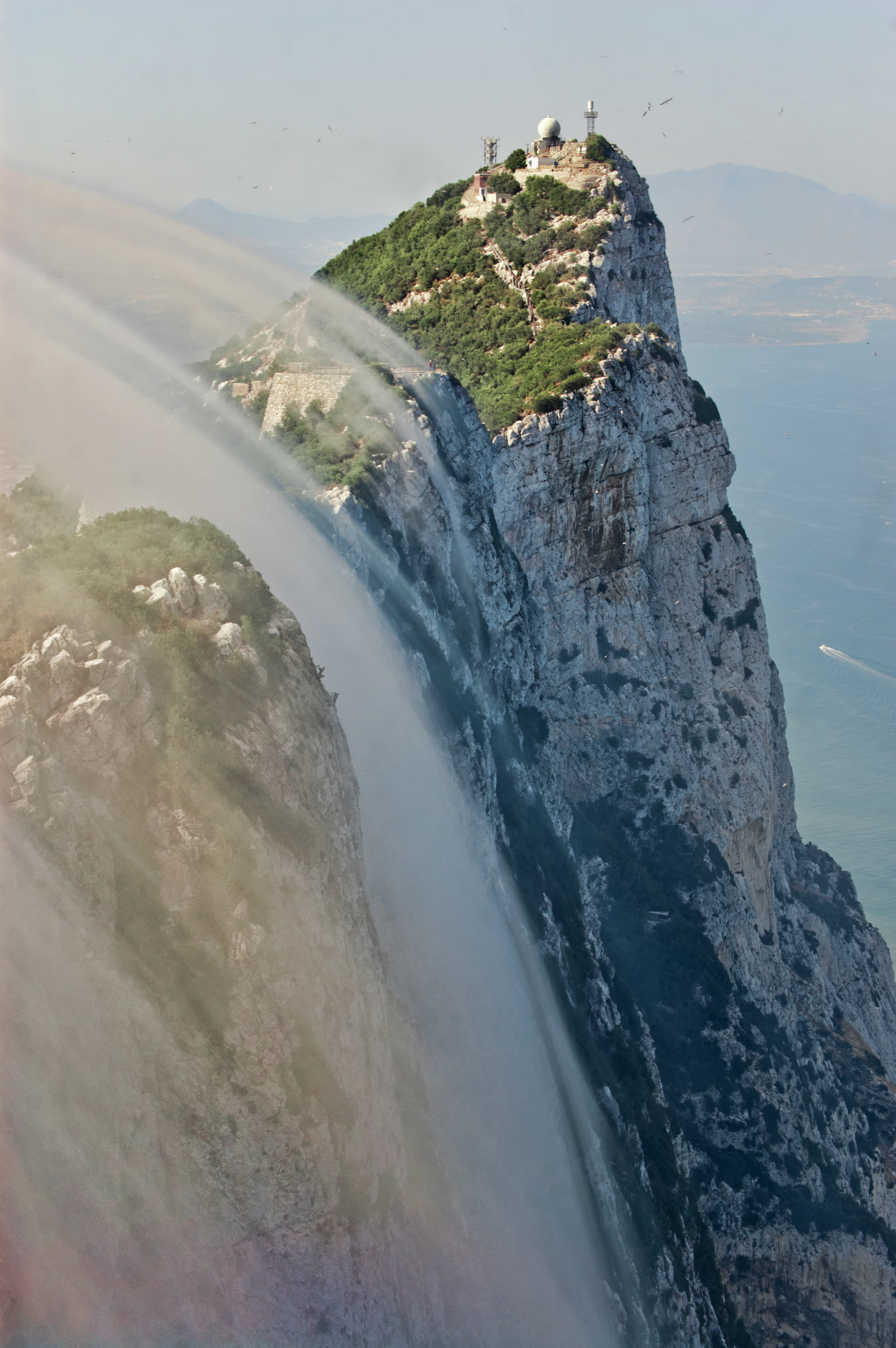|
Klippe
350px, Schematic overview of a thrust system. The shaded material is called a window or fenster. The klippe is the isolated block of the nappe overlying autochthonous material. A klippe (German language">German for cliff or crag) is a geological feature of thrust fault terrains. The klippe is the remnant portion of a nappe after erosion has removed connecting portions of the nappe. This process results in an outlier of exotic, often nearly horizontally translated strata overlying autochthonous strata. Examples of klippes include: * Chief Mountain, Montana * Mount Yamnuska, Alberta *The Rock of Gibraltar Klippes may also be found in the Pre-Alps of Switzerland and some of the isolated mountains in Assynt Assynt ( gd, Asainn or ) is a sparsely populated area in the south-west of Sutherland, lying north of Ullapool on the west coast of Scotland. Assynt is known for its landscape and its remarkable mountains, which have led to the area, along with ..., Sutherland, in NW Scotl ... [...More Info...] [...Related Items...] OR: [Wikipedia] [Google] [Baidu] |
Nappe
In geology, a nappe or thrust sheet is a large sheetlike body of rock that has been moved more than or above a thrust fault from its original position. Nappes form in compressional tectonic settings like continental collision zones or on the overriding plate in active subduction zones. Nappes form when a mass of rock is forced (or "thrust") over another rock mass, typically on a low angle fault plane. The resulting structure may include large-scale recumbent folds, shearing along the fault plane,Twiss, Robert J. and Eldridge M. Moores, ''Structural Geology,'' W. H. Freeman, 1992, p. 236 imbricate thrust stacks, fensters and klippes. The term stems from the French word for '' tablecloth'' in allusion to a rumpled tablecloth being pushed across a table. History Nappes or nappe belts are a major feature of the European Alps, Dinarides, Carpathians and Balkans. Since the 19th century many geologists have uncovered areas with large-scale overthrusts. Some of these were s ... [...More Info...] [...Related Items...] OR: [Wikipedia] [Google] [Baidu] |
Thrust Fault
A thrust fault is a break in the Earth's crust, across which older rocks are pushed above younger rocks. Thrust geometry and nomenclature Reverse faults A thrust fault is a type of reverse fault that has a dip of 45 degrees or less. If the angle of the fault plane is lower (often less than 15 degrees from the horizontal) and the displacement of the overlying block is large (often in the kilometer range) the fault is called an ''overthrust'' or ''overthrust fault''. Erosion can remove part of the overlying block, creating a ''fenster'' (or '' window'') – when the underlying block is exposed only in a relatively small area. When erosion removes most of the overlying block, leaving island-like remnants resting on the lower block, the remnants are called ''klippen'' (singular '' klippe''). Blind thrust faults If the fault plane terminates before it reaches the Earth's surface, it is referred to as a ''blind thrust'' fault. Because of the lack of surface evidence, blind ... [...More Info...] [...Related Items...] OR: [Wikipedia] [Google] [Baidu] |
Chief Mountain
Chief Mountain ('' Blackfoot: Ninaistako'') () is located in the U.S. state of Montana on the eastern border of Glacier National Park and the Blackfeet Indian Reservation. The mountain is one of the most prominent peaks and rock formations along the Rocky Mountain Front, a long overthrust fault, known as the Lewis Overthrust, which extends from central Montana into southern Alberta, Canada. The peak The peak is easily seen from Montana and Alberta due to the rapid altitude gain over the Great Plains which are immediately east of the mountain. Chief Mountain is an example of a klippe. It consists of a Precambrian block which rests directly above much younger Cretaceous gray shales. The 600 million year old Precambrian rocks are 400-500 million years older than the Cretaceous rocks at the base of the mountain. Having an older layer of rock juxtaposed atop younger basement rocks is found on occasion in thrust faults and is commonplace along the Lewis Overthrust whi ... [...More Info...] [...Related Items...] OR: [Wikipedia] [Google] [Baidu] |
Thrust System En
Thrust is a reaction force described quantitatively by Newton's third law. When a system expels or accelerates mass in one direction, the accelerated mass will cause a force of equal magnitude but opposite direction to be applied to that system. The force applied on a surface in a direction perpendicular or normal to the surface is also called thrust. Force, and thus thrust, is measured using the International System of Units (SI) in newtons (symbol: N), and represents the amount needed to accelerate 1 kilogram of mass at the rate of 1 meter per second per second. In mechanical engineering, force orthogonal to the main load (such as in parallel helical gears) is referred to as static thrust. Examples A fixed-wing aircraft propulsion system generates forward thrust when air is pushed in the direction opposite to flight. This can be done by different means such as the spinning blades of a propeller, the propelling jet of a jet engine, or by ejecting hot gases from a rocke ... [...More Info...] [...Related Items...] OR: [Wikipedia] [Google] [Baidu] |
Beckov Castle, Slovakia, From Below
Beckov ( hu, Beckó) is a village and municipality in Nové Mesto nad Váhom District in the Trenčín Region of western Slovakia. History In historical records the village was first mentioned in 1208. ''Mihály de genere Bána'', royal equerry, who was the forefather of the Cseszneky family, performed several heroic deeds against the Mongolian invaders of Hungary (during the invasion in 1241–42) and for his bravery in 1241 King Béla IV appointed him Count (''comes'') of Beckó. Geography The municipality lies at an altitude of 190 metres and covers an area of 28.629 km2. It has a population of about 1375 people. Sights Above the village is Beckov Castle, now in ruins. People * Jozef Miloslav Hurban born 1817 * Baron László Mednyánszky born 1852 * Dionýz Štúr born 1827 Gallery Image:Beckocivertanlegi1.jpg Image:Beckocivertanlegi2.jpg Image:Beckocivertanlegi3.jpg Sources * Györffy György: Az Árpád-kori Magyarország történeti földrajza Genealog ... [...More Info...] [...Related Items...] OR: [Wikipedia] [Google] [Baidu] |
German Language
German ( ) is a West Germanic language mainly spoken in Central Europe. It is the most widely spoken and official or co-official language in Germany, Austria, Switzerland, Liechtenstein, and the Italian province of South Tyrol. It is also a co-official language of Luxembourg and Belgium, as well as a national language in Namibia. Outside Germany, it is also spoken by German communities in France ( Bas-Rhin), Czech Republic (North Bohemia), Poland ( Upper Silesia), Slovakia (Bratislava Region), and Hungary ( Sopron). German is most similar to other languages within the West Germanic language branch, including Afrikaans, Dutch, English, the Frisian languages, Low German, Luxembourgish, Scots, and Yiddish. It also contains close similarities in vocabulary to some languages in the North Germanic group, such as Danish, Norwegian, and Swedish. German is the second most widely spoken Germanic language after English, which is also a West Germanic language. German ... [...More Info...] [...Related Items...] OR: [Wikipedia] [Google] [Baidu] |
Cliff
In geography and geology, a cliff is an area of rock which has a general angle defined by the vertical, or nearly vertical. Cliffs are formed by the processes of weathering and erosion, with the effect of gravity. Cliffs are common on coasts, in mountainous areas, escarpments and along rivers. Cliffs are usually composed of rock that is resistant to weathering and erosion. The sedimentary rocks that are most likely to form cliffs include sandstone, limestone, chalk, and dolomite. Igneous rocks such as granite and basalt also often form cliffs. An escarpment (or scarp) is a type of cliff formed by the movement of a geologic fault, a landslide, or sometimes by rock slides or falling rocks which change the differential erosion of the rock layers. Most cliffs have some form of scree slope at their base. In arid areas or under high cliffs, they are generally exposed jumbles of fallen rock. In areas of higher moisture, a soil slope may obscure the talus. Many cliffs als ... [...More Info...] [...Related Items...] OR: [Wikipedia] [Google] [Baidu] |
Geological
Geology () is a branch of natural science concerned with Earth and other astronomical objects, the features or rocks of which it is composed, and the processes by which they change over time. Modern geology significantly overlaps all other Earth sciences, including hydrology, and so is treated as one major aspect of integrated Earth system science and planetary science. Geology describes the structure of the Earth on and beneath its surface, and the processes that have shaped that structure. It also provides tools to determine the relative and absolute ages of rocks found in a given location, and also to describe the histories of those rocks. By combining these tools, geologists are able to chronicle the geological history of the Earth as a whole, and also to demonstrate the age of the Earth. Geology provides the primary evidence for plate tectonics, the evolutionary history of life, and the Earth's past climates. Geologists broadly study the properties and processes of Earth ... [...More Info...] [...Related Items...] OR: [Wikipedia] [Google] [Baidu] |
Erosion
Erosion is the action of surface processes (such as water flow or wind) that removes soil, rock, or dissolved material from one location on the Earth's crust, and then transports it to another location where it is deposited. Erosion is distinct from weathering which involves no movement. Removal of rock or soil as clastic sediment is referred to as ''physical'' or ''mechanical'' erosion; this contrasts with ''chemical'' erosion, where soil or rock material is removed from an area by dissolution. Eroded sediment or solutes may be transported just a few millimetres, or for thousands of kilometres. Agents of erosion include rainfall; bedrock wear in rivers; coastal erosion by the sea and waves; glacial plucking, abrasion, and scour; areal flooding; wind abrasion; groundwater processes; and mass movement processes in steep landscapes like landslides and debris flows. The rates at which such processes act control how fast a surface is eroded. Typically, physical ... [...More Info...] [...Related Items...] OR: [Wikipedia] [Google] [Baidu] |
Autochthonous
Autochthon, autochthons or autochthonous may refer to: Fiction * Autochthon (Atlantis), a character in Plato's myth of Atlantis * Autochthons, characters in the novel ''The Divine Invasion'' by Philip K. Dick * Autochthon, a Primordial in the '' Exalted'' role-playing game * Autochthons, powerful angelic beings in Fall; or, Dodge in Hell Nature * Autochthon (geology), a sediment or rock that can be found at its site of formation or deposition * Autochthon (nature), or landrace, an indigenous animal or plant * Autochthonous landrace, a plant or animal that is native to a particular agricultural system * Autochthonous transmission, the spread of disease between two individuals in the same place * ''Autochton'' (butterfly), a genus of butterflies Society * Autochthon (ancient Greece), a concept or mythology of a people born from the land * Autochthonous language, the language of an indigenous people * Autochthonism or Indigenism, ethnic nationalism promoting the identity of ... [...More Info...] [...Related Items...] OR: [Wikipedia] [Google] [Baidu] |
Mount Yamnuska
Mount John Laurie is a mountain in the Canadian Rockies, located in Alberta's Municipal District of Bighorn No. 8. Various names Officially named Mount John Laurie in 1961, it is also known as Mount Laurie, or by the Nakoda name ''Mount Yamnuska'', or simply ''Yamnuska''. ''Yamnuska'' translates to "wall of stone" and is derived from the Stoney Nakoda word that describes steep cliffs or "the flat faced mountain." John Lee Laurie, 1899–1959, was a founder of the Indian Association of Alberta. The mountain's 1961 renaming came at the request of the Stoney Nakoda First Nation. Laurie, an educator and political activist, served as secretary of the Indian Association of Alberta from 1944 to 1956, promoting the causes of First Nations in Alberta. Peak and climbing Standing at approximately above sea level, Mount John Laurie is the last mountain on the north side of the Bow River valley (Bow Valley) as it exits the mountains for the foothills and prairie of Alberta. Located ... [...More Info...] [...Related Items...] OR: [Wikipedia] [Google] [Baidu] |
Rock Of Gibraltar
The Rock of Gibraltar (from the Arabic name Jabel-al-Tariq) is a monolithic limestone promontory located in the British territory of Gibraltar, near the southwestern tip of Europe on the Iberian Peninsula, and near the entrance to the Mediterranean. It is high. Most of the Rock's upper area is covered by a nature reserve, which is home to around 300 Barbary macaques. These macaques, as well as a labyrinthine network of tunnels, attract many tourists each year. The Rock of Gibraltar, one of the two traditional Pillars of Hercules, was known to the Romans as ''Mons Calpe'', the other pillar being ''Mons Abila'', either Monte Hacho or Jebel Musa on the African side of the Strait. According to ancient myths fostered by the Greeks and the Phoenicians, and later perpetuated by the Romans, the two points marked the limit to the known world, although the Phoenicians had actually sailed beyond this point into the Atlantic, both northward and southward. The Mediterranean Sea surroun ... [...More Info...] [...Related Items...] OR: [Wikipedia] [Google] [Baidu] |







